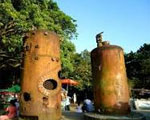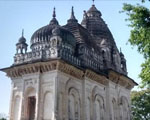|
Destination News |
 |
|
On a quest to
make fort Kochi
'differently-abled
tourist-friendly
spot' |
| |
|
| |
If things go as
per plan, Fort
Kochi will
become Kerala's
first
'differently-abled
tourist-friendly
spot', a step
which would
attract foreign
and domestic
tourists into
the region in
large numbers.
The Tourism
Department is
aiming to make
the announcement
on December 3 -
the
International
Day of Persons
with
Disabilities.
The feasibility
study to make
Fort Kochi a
differently-abled
tourist-friendly
spot began the
other day. The
study is
conducted by the
technical
department of
the National
Service Scheme (NSS),
which comprises
of students from
NSS units of
engineering
colleges in the
state. Simon
George, chairman
of Prathyasha
Foundation, a
public
charitable
organization for
uplifting
differently-abled
to the forefront
of the society,
is the brain
behind the
project. |
|
 |
|
Tourism with
a twist: Taste a
prison for a
price
The
first-of-a-kind
trend fast
catching on in
Telangana |
| |
|
| |
You need not
break a law and
get caught by
police to taste
a life of a
prisoner for a
day in this
prison in India.
Instead you can
experience
behind-the-bars
experience for a
paltry sum of Rs
500, which
equates to
roughly 7 Euros.
This offer comes
from a
colonial-era
jail here in
Medak district
of Telangana, a
southern state
in India.
Tourists can now
get a firsthand
experience of
prison life,
albeit for a
day.
The 220-year-old
District Central
Jail at
Sangareddy,
which has now
been converted
into a museum,
offers a 24-hour
confinement
under an
innovative
initiative
called ‘Feel the
Jail’ launched
by the Prisons
department for
people with a
taste for the
offbeat and want
to experience
detention.
During the stay,
‘inmates’ will
be provided with
a prison
uniform, made of
khadi, a steel
meal plate and a
glass, a mug, a
bathing soap,
bedding and
other facilities
as per state
prison manual,
besides a fan.
A prior
intimation would
be needed to
avail this offer
so that jail
authorities can
make necessary
arrangements for
the visiting
inmates. |
|
 |
|
The
Pratapeshwar
Temple at
Khajuraho set to
open for tourism |
| |
|
| |
One of the most
mysterious
properties of
Khajuraho —
Pratapeshwar
Temple — will
soon be opened
for tourism. The
Archaeological
Survey of India
(ASI), which has
been maintaining
other temples in
Western Complex,
will take over
the temple for
protection.
“The temple is
closed since
1956 as per the
States
Reorganisation
Act, where all
heritage
properties were
considered to be
princely by
either the state
or the central
government. Due
to some reasons,
the state
archeology
department was
unable to take
care of the
property and
therefore it was
sealed,” said a
senior
archaeology
officer.
The temple
manages to
attract a lot of
attention by
tourists. “The
temple is in the
same complex
which has
Vishwanath
Temple, Devi
Mandap, Lakshman
Temple,
Kandariya
Mahadev and Devi
Jagdambi Temple.
Though the
Pratapeshwar
Temple is
closed, we
introduce it to
the tourists and
narrate its
importance in
Khajuraho. They
can view it from
outside,” said
Prayas Badkul,
an owner of a
tourist guide
organisation in
Khajuraho.
“The
Pratapeshwar
Temple was built
by Raja Pratap
Singh as a
memorial of
himself, to
immortalise his
name. Kings back
then, used to
build monuments
on their names
to glorify
themselves and
to be at par
with the God.
The temple is an
interesting
conglomeration
of three
Hinduistic
cultural
architecture
techniques. It
has a Rajputana
dome in the
front, a pagoda
style of ceiling
in the middle
and then a
typical
brahminical
Shikhara
(summit) at the
back. It is the
only temple that
represents the
18th century
contemporary
carving and
structure,” said
Sudesh Tamrakar,
a senior tourist
guide in
Khajuraho.
On being asked
what is inside
the temple,
Tamrakar said:
“It is said that
it has a
‘shivling’ made
of black stone.
Usually, kings
after creating
such monuments
on their names,
used to
establish some
sort of
mythological
statue for the
sake of its
protection.”
“Pratapeshwar
temple, like
other temples in
Khajuraho, also
belongs to the
‘non-living’
temple category
as there are no
traces of
worshipping
inside the
temple by
locales. It is
still indefinite
to say how much
of the temple
will be opened
because once ASI
starts working
on a site,
several
historical
facets of that
particular
property are
unfolded. Since
the temple was
closed for so
many years, it
becomes
difficult to
comment,” said
Zulfiqar Ali,
superintending
archaeologist,
Bhopal. |
|
|